As a last treat for the Historical Sew-Fortnightly ‘By the Sea’ week, I thought you might enjoy seeing the one piece* of vintage swimwear in my collection: a late ’30s, or 1940s knit wool swimsuit from the Canterbury of New Zealand. (*Actually, that’s not entirely true. I do have a couple of late ’50s/early ’60s swimsuits – but this one might be as early as 1938, so replicating it would be within the HSF guidelines).

NZ, as a major wool producer, had a number of its own woollen mills and manufacturers in the 19th and throughout the 20th century. One of these was the Canterbury Woollen Mills, based in Ashburton, just south of Christchurch, in the Canterbury region of the South Island. The mill was actually known as the Ashburton Woollen Mills from its founding in 1885 until 1890. I am relatively certain that it was this mill that produced Canterbury swimwear (just like the Roslyn Woollen Mill produced Roslyn swimwear)
Protectionist laws throughout most of the 20th century made importing clothes prohibitively expensive, so instead of bringing in brands like Jantzen, NZ shoppers bought local versions, and swimsuits by Canterbury and Kaiapoi and Roslyn are much more easily found at antique stores and auctions.
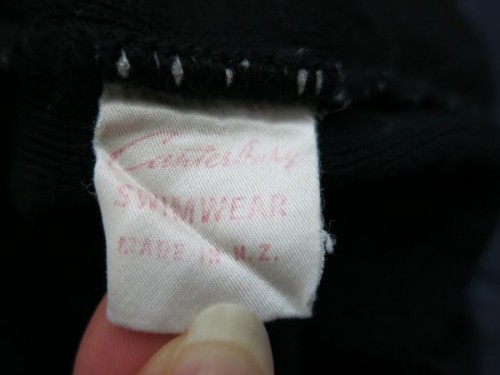
I found my swimsuit at a small antique store in Nelson over Christmas. It’s made from a midweight wool knit – it’s quite a fine, nice wool, not at all scratchy.
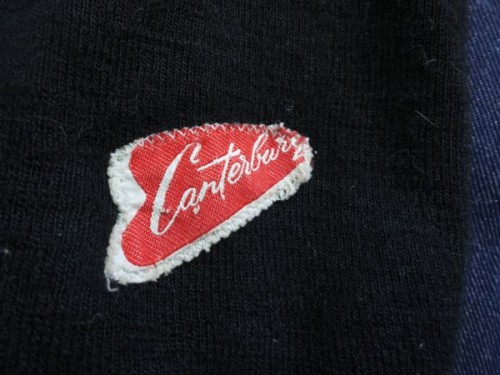
Although the swimsuit is made of knit fabric, all the shaping is achieved through sewn seams, allowing it to fit snugly to a woman’s curves – that, along with the materials used, logo font, construction and overall aesthetic, help me to date it to no earlier than the mid-1930s, and no later than the end of the ’40s, when cotton and synthetics started to be used in NZ swimwear, and the logo changed.
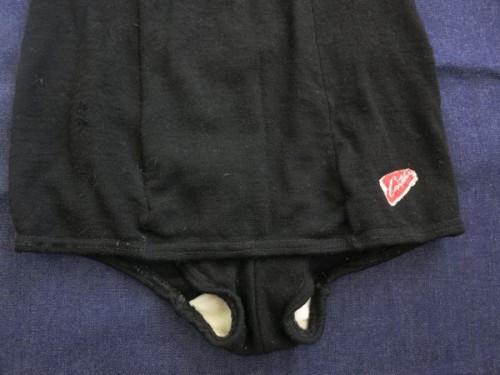
The swimsuit label states that it is for a 40″ bust, so too big for me. It’s quite generously sized: the bottom seems shaped for hips around 44″”, and the waist isn’t particularly defined.

The bust area is fully lined with heavy unbleached cotton, shaped to support the bust.
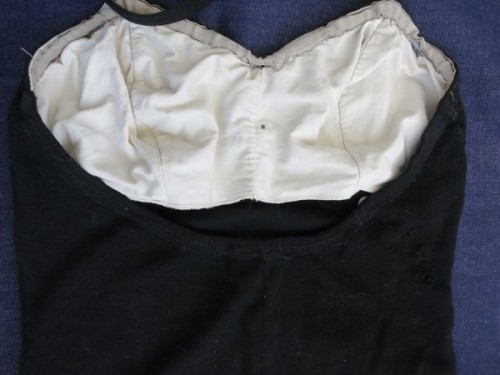
The bust is held snug against the chest with a line of elastic run through a line of twill tape from underarm to underarm. The twill tape is hand stitched down at the bottom, and may be a later addition, or the elastic may have been replaced at some point when the original elastic perished.
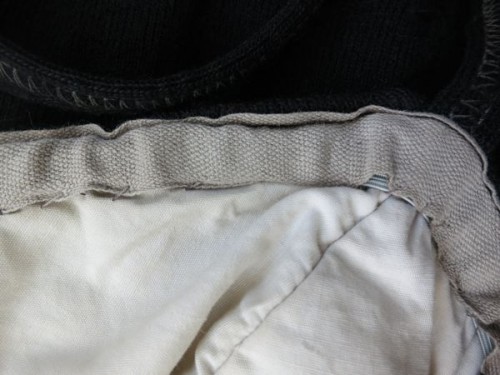
The swimsuit is held up with two long straps which fasten to buttons on the back. The straps each have four worked buttoholes, allowing the straps to be fastened in an X across the back, or straight down from the shoulder.
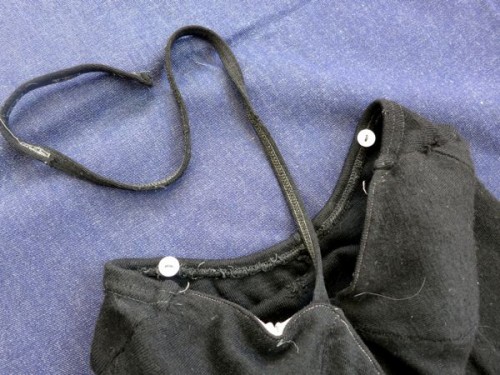
The buttons are simple white two-hole buttons. They appear to be original, and to be made from an early plastic.

All of the interior seams of the swimsuit are finished with overlocking. Overlocking machines were actually invented in the 1880s, and were commonly used for commercial knitwear from the early 20th century, though they would not become common for home seamstresses until the 1970s.
The edges are all finished with overlocked and double-stitched single-turn hems.
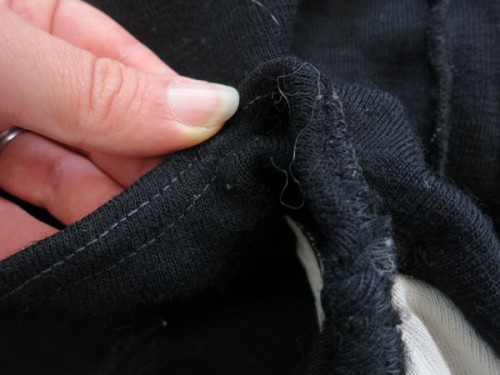
The crotch area of the swimsuit is protected by a layer of white cotton knit which, as part of the crotch-piece, is sewn into the princess seams at the side fronts of the false skirt front.
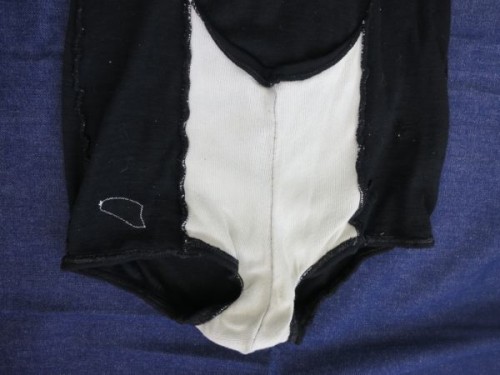
Other than the bust area and crotch, the swimsuit is unlined, but the wool was so fine that I did not find it uncomfortable to wear around the house for a couple of hours (just to see – as it is a vintage piece I won’t be swimming in it, though I’d love to know how it would react).

The swimsuit is generally in quite good condition, and is totally wearable, but it does have a number of small holes that have been carefully darned.
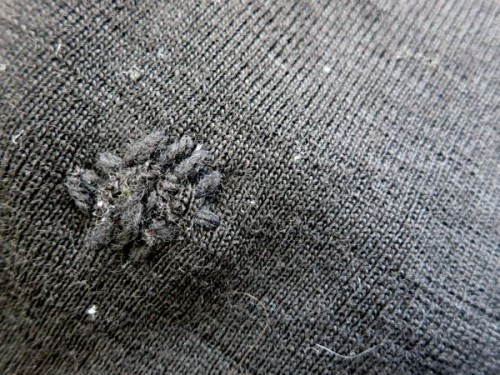
The holes are located mostly in the midriff area. I have a soft spot for mends and darns, and rather like garments that have them more than garments that are in pristine condition. A mend tells a story of wear: of a garments used and loved and needed.
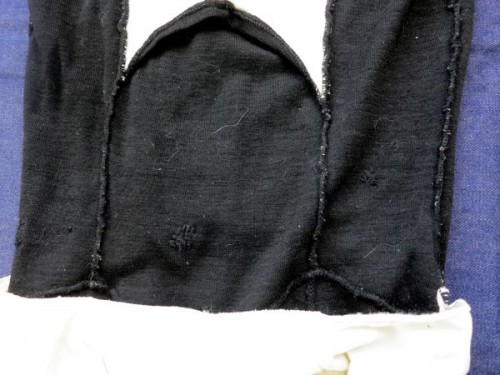
I wonder who the woman who bought and owned and wore, and hopefully swam in, this swimsuit was, with her 40″ bust. Did she like black, or was that just the cheap, practical colour? Did she feel pretty in this swimsuit? Confident when wearing it? I hope so.
Someday I’d like to find a model in the right size to do a very careful, gentle photoshoot in the swimsuit.

I think it’s really nice, darns and all. I just measured myself but I think I’ve lost size since my last measurements as I’m now 38″ bust and 43″ hip which is a little too small. Mind you being in Christchurch would make things logistically difficult too!
Oops, forgot to say that it’s good to know about the timing of overlockers being developed. I have one and now know I can use it for some stuff if what I’m making would have been available commercially. Would have made the hems on my trousers easier than the binding I’ve used.
I have a Jantzen suit in my collection that is very similar, with the seaming under the bust, the modest panel and the straps. I found an ad to go with mine – 1937.
Thanks! I suspected that mine dates to between 36-38 based on its similarity to swimsuit ads from those years.
What a find! And in such good condition. A treasure. How interesting that it wasn’t scratchy to wear – I used to wonder about that. Woollen swimsuits had gone for women in NZ by the time I came along, but my father’s swimsuit was black wool, short trunks with a ‘modesty panel’ at the front. They got moth, and were thrown out.
I think woollen swimsuits for women and girls may have persisted in the UK after WWII, possibly up to the sixties. I loved (and love) the books by Monica Edwards, the stories of young people living on the Romney Marsh, by the sea. Tamzin and Rissa, the two girls, had navy blue woollen suits they wore to swim in the sea. They are described as tending to go to holes with age.
Very cool! Also, if you don’t find any models that you prefer, I’m about that size.
I wish I was that size! I’m so curious to see how it would wear/feel. I love vintage knits and swimwear. What a lovely find! Finding vintage garments that were mended makes them more… I don’t know… human? real? I’m not sure what the right word is, but it makes one feel a bit more connected with the garment. Thanks for showing us the lining. I was always curious to know what one would use to line the wool suits in that era. And it’s great to see the bust shaping taking place. Really neat!
My vintage knitting pattern collection is full of patterns to knit swimming costumes. My first thought was “Wool? In the heat?” and then I had to wonder if the costume would become waterlogged upon diving in the water and make the wearer sink. I have knitted bikini patterns too and I would definitely keep a knitted bikini dry – imagine if the bottoms got waterlogged, sank and slid off the legs? Lawks!
I didn’t realise that knitted costumes were produced commercially. Very interesting. The fact that yours does not scratch is interesting too.
The protectionist laws you speak of reminds me of a story I heard years ago. A colleague had worked in New Zealand in the 1960’s and he said that it was almost impossible to get shoes where he lived as the imports were indeed prohibitively expensive. It strikes a cord with me, because even all these years later, when most of our goods are imported, I have been unable to find a shop which stocks brown court shoes for the last two years. Different times, different limitations.
I may be the right size!
Fascinating. But I have to say, the idea of wool swimsuits makes me itchy just thinking about it.
What a lovely swimsuit! I SO wish I lived anywhere near you (instead of half a world away) – based on the measurements you have I think it would fit me perfectly, and I love doing photo shoots.